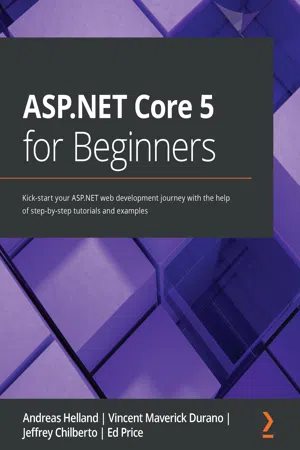
ASP.NET Core 5 for Beginners
Kick-start your ASP.NET web development journey with the help of step-by-step tutorials and examples
- 598 pages
- English
- ePUB (mobile friendly)
- Available on iOS & Android
ASP.NET Core 5 for Beginners
Kick-start your ASP.NET web development journey with the help of step-by-step tutorials and examples
About this book
Learn how to build web applications efficiently using ASP.NET Core 5 with the C# programming language and related frameworks
Key Features
- Build web apps and services and cross-platform applications using.NET and C#
- Understand different web programming concepts with the help of real-world examples
- Explore the new features and APIs in ASP.NET Core 5, EF Core, Visual Studio, and Blazor
Book Description
ASP.NET Core 5 for Beginners is a comprehensive introduction for those who are new to the framework. This condensed guide takes a practical and engaging approach to cover everything that you need to know to start using ASP.NET Core for building cloud-ready, modern web applications.
The book starts with a brief introduction to the ASP.NET Core framework and highlights the new features in its latest release, ASP.NET Core 5. It then covers the improvements in cross-platform support, the view engines that will help you to understand web development, and the new frontend technologies available with Blazor for building interactive web UIs. As you advance, you'll learn the fundamentals of the different frameworks and capabilities that ship with ASP.NET Core. You'll also get to grips with securing web apps with identity implementation, unit testing, and the latest in containers and cloud-native to deploy them to AWS and Microsoft Azure. Throughout the book, you'll find clear and concise code samples that illustrate each concept along with the strategies and techniques that will help to develop scalable and robust web apps.
By the end of this book, you'll have learned how to leverage ASP.NET Core 5 to build and deploy dynamic websites and services in a variety of real-world scenarios.
What you will learn
- Explore the new features and APIs introduced in ASP.NET Core 5 and Blazor
- Put basic ASP.NET Core 5 concepts into practice with the help of clear and simple samples
- Work with Entity Framework Core and its different workflows to implement your application's data access
- Discover the different web frameworks that ASP.NET Core 5 offers for building web apps
- Get to grips with the basics of building RESTful web APIs to work with real data
- Deploy your web apps in AWS, Azure, and Docker containers
- Work with SignalR to add real-time notifications to your app
Who this book is for
This book is for developers who want to learn how to develop web-based applications using the ASP.NET Core framework. Familiarity with the C# language and a basic understanding of HTML and CSS is required to get the most out of this book.
Frequently asked questions
- Essential is ideal for learners and professionals who enjoy exploring a wide range of subjects. Access the Essential Library with 800,000+ trusted titles and best-sellers across business, personal growth, and the humanities. Includes unlimited reading time and Standard Read Aloud voice.
- Complete: Perfect for advanced learners and researchers needing full, unrestricted access. Unlock 1.4M+ books across hundreds of subjects, including academic and specialized titles. The Complete Plan also includes advanced features like Premium Read Aloud and Research Assistant.
Please note we cannot support devices running on iOS 13 and Android 7 or earlier. Learn more about using the app.
Information
Section 1 – Crawling
- Chapter 1, Introduction to ASP.NET Core 5
- Chapter 2, Cross-Platform Setup
- Chapter 3, Dependency Injection
- Chapter 4, Razor View Engine
- Chapter 5, Getting Started with Blazor
Chapter 1: Introduction to ASP.NET Core 5
- Explaining ASP.NET Core
- Refreshing your C# knowledge
- Learning what's new with .NET 5 and C# 9
- Understanding websites and web servers
- Exploring Visual Studio Code
- Leveraging Windows Terminal
Technical requirements
- Visual Studio 2019: Visual Studio can be downloaded from https://visualstudio.microsoft.com/vs/community/. The Community edition is free and will work for the purposes of this book.
- Visual Studio Code: Visual Studio Code can be downloaded from https://code.visualstudio.com/Download.
- .NET Core 5: The .NET Core framework can be downloaded from https://dotnet.microsoft.com/download/dotnet/5.0.

Explaining ASP.NET Core
Managed versus unmanaged code
Introducing the .NET platform
Table of contents
- ASP.NET Core 5 for Beginners
- Why subscribe?
- Preface
- Section 1 – Crawling
- Chapter 1: Introduction to ASP.NET Core 5
- Chapter 2: Cross-Platform Setup
- Chapter 3: Dependency Injection
- Chapter 4: Razor View Engine
- Chapter 5: Getting Started with Blazor
- Section 2 – Walking
- Chapter 6: Exploring the Blazor Web Framework
- Chapter 7: APIs and Data Access
- Chapter 8: Working with Identity in ASP.NET
- Chapter 9: Getting Started with Containers
- Section 3 – Running
- Chapter 10: Deploying to AWS and Azure
- Chapter 11: Browser and Visual Studio Debugging
- Chapter 12: Integrating with CI/CD
- Chapter 13: Developing Cloud-Native Apps
- Assessments
- Other Books You May Enjoy